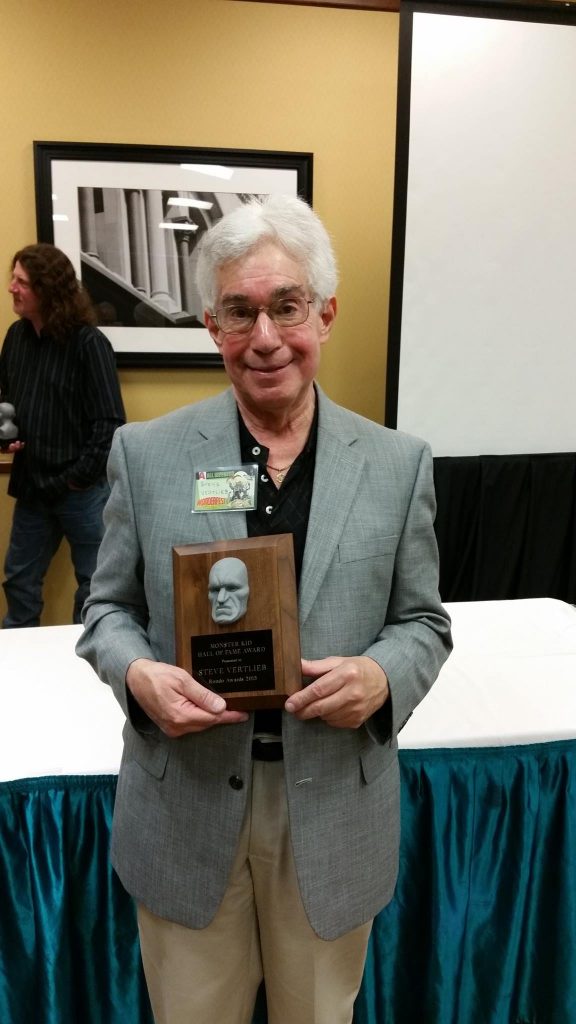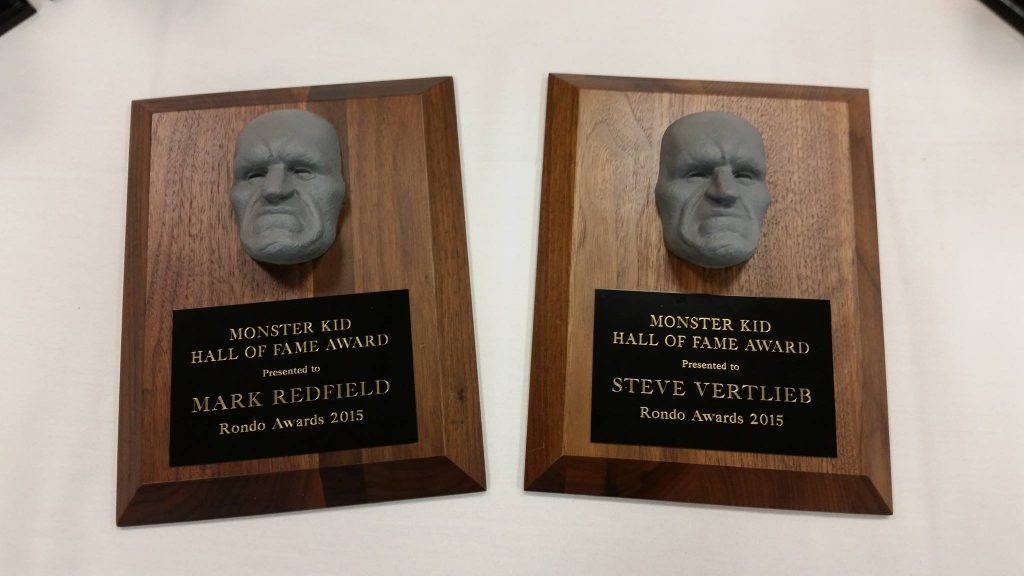(1) PROOF AND REPROOF. David Brin, after congratulating N.K. Jemisin for her latest Hugo win, asks readers to predict what’s coming next in the sff genre, in “Perspectives from Science Fiction: Hugos and other marvels”.
Oh and also, let’s celebrate that science fiction has always – and yes always, ever since it was founded by our revered grandmother of SF, Mary Wollstonecraft (Shelley) – been the genre of literature most welcoming to bold ideas about human and non-human diversity, and brashly exploratory authors. Yes, SF was always “better than its times” when it came to such things, though every decade deserved the reproof of later decades, for its own myopic misdeeds. Leaving our self-critical movement always looking for the next cause for self-improvement!
So what are we doing now, that will cause later generations of brave questioners and boundary-pushers to reprove? What terrible habit will reformers tell us to break next, when we get the upper hand on racism, sexism and cultural conformity? I think I know what it will be! (Hint: what is the most harmful and nasty thing that even good people now routinely do to each other, with barely a thought to fairness or consequences? And I include people as good as you envision yourself to be. Discuss in comments, below.)
(2) THE SHAPE OF YEARS TO COME. And at Examined Worlds, Ethan Mills wants to know “Where did all the far-future science fiction go?”
This is a question I’ve thought about a lot lately. I recently re-read the last book in the Dune series and am working my way through the delightfully/impossibly difficult Book of the New Sun, which my Goodreads review describes as “like taking an acid trip through a thesaurus.”
These days far-future stuff is harder to find. There’s even a popular genre of science fiction that takes place in the past: steampunk. Contemporary readers will call a book “far future” if it takes place a mere few hundred years or even sooner. See this list of allegedly “far future” science fiction that puts Kim Stanley Robinson’s 2312 on the list, and even more weirdly, Charles Stross’s Accelerando. One of the main complaints about Neal Stephenson’s Seveneves was that people didn’t care for the the part that takes place in thousands of years (which for the record was my favorite part — see my review for more).
(3) THE RONDO OF A LIFETIME. Steven J. Vertlieb recently found buried digital treasure:
Discovered these wonderful photographs for the first time recently on my brother’s cell phone while vacationing in Los Angeles just a couple of weeks ago. This marvelous shot was taken in Louisville, Kentucky during the prestigious annual Rondo Award ceremony in early June, 2016, after which actor, director, artist, writer, and old pal Mark Redfield and I were awarded these coveted Rondo “Hall of Fame” plaques in joyous recognition of a lifetime of creative productivity, and dedication to the arts.
(4) PUPPIES AND RACE. In “Words Matter, Actions Matter and Race Definitely Matters” at Amazing Stories, Chris M. Barkley rebuts author Christopher Nuttall’s editorial, “A Character Who Happens To Be Black”.
When a writer, of any ethnicity, admits using characters of different ethnicities without even the slightest hint of any sort of context for doing so, it is the worst sort of cultural appropriation and is an insult to his readers as well. Using the “I don’t see color” explanation to pander his own world view about race may be satisfying to his bubble of readers ordering online, but I am quite willing to bet it would not pass muster at most publishing houses or with discerning and critical readers as well.
By erasing ethnicity, class or race as a factor in his characters, Mr. Nuttal is stating those centuries of history and culture, on which his future or fantasy worlds are built upon, don’t matter or worse, never happened. By homogenizing his black characters with his white male viewpoint, he is giving them the “gift” of being white and being as good as anyone else and calling for their heritage and culture is a bad thing and should essentially be swept under the rug. His attempt to do so does not make them equal, it diminishes them. It’s disingenuous at the very least and a patronizing example of white privilege at worse.
No person who is consciously aware of their ethnicity, culture and history would tolerate such a cleansing. By taking away their joy, you also take away their sorrow and their history. We are all human and that is the factor that should unites us, not divide us. By erasing our differences to make everyone the same, no one is special or an individual.
(5) APOLOGIZING. At Fast Company, Mike Su proffers “7 Lessons White People Can Learn From Bodega’s Apology”.
… Setting aside the idea of rebranding a mini-bar and putting it in apartment buildings and street corners and calling it disruption, there are some important lessons that can be learned from their poor apology that can be particularly important for well-meaning white people to understand when they unintentionally offend. Here are my key takeaways:
1. “I Didn’t Mean To” Doesn’t Matter
“Despite our best intentions and our admiration for traditional bodegas…”
Most of the post was focused on helping people understand what they were really trying to do. Why they weren’t super evil, and all the steps that they took, and basically, “I know we seemed like assholes, but we’re not! Or, at least, we didn’t mean to be!”
But here’s the thing?—?just cause you didn’t mean to hurt someone doesn’t mean you didn’t actually hurt them.
But if you spend all your time explaining what you meant to do?—?you’re spending all your effort on trying to make yourself look less bad, and make yourself feel less bad. That may do it for you, but then your apology is not about actually making the person you offended feel any better. Which leads me to…
(6) IN THE NEWS. Brookline, MA Town Meeting member (and noted sf writer) Michael A. Burstein isn’t kidding: “Town Leaders Seek to Make ‘Selectwoman’ the Official Title”.
“There’s been some recent interest in Massachusetts to change the name of board of selectmen to something that would be a bit more gender-neutral,” said Michael Burstein, a town meeting member.
Two warrants have been submitted to the Board of Selectmen and take aim at changing the governing body’s title and title of its members.
“One of them is kind of a straight forward and just wants to create gender-neutral language,” said Hamilton.
The other warrant filed by Burstein is very specific.
“I deliberately and specifically filed a warrant to change the name of Board of Selectmen to Board of Selectwomen,” he said.
The Boston NBC affiliate interviewed him for its September 14 news broadcast.
“”
(7) ROMM OBIT. SF Site News reports the death of Minneapolis fan Baron Dave Romm.
Fan Dave E Romm (b.1955) died on September 14. Dave was active in Minneapolis fandom and was an avid photographer, taking pictures of various Minicons and other conventions he was able to get to. He traveled to Antarctic in 2005 and wrote about his experience in Argentus. He also hosted Shockwave Radio Theatre on KFAI-AM and archived the podcasts on his website. Romm became a baron of the micro-country of Ladonia in 2001.
(8) GOGOS OBIT. Bloody Disgusting bids farewell to “Legendary Monster Artist Basil Gogos” (1939-2017) who died September 14.
Some of the most iconic pieces of classic monster art were found on the front covers of Famous Monsters of Filmland magazine throughout the ’60s and ’70s, that art no doubt responsible for countless monster kids being bitten by the proverbial bug. Vibrant and eye-catching, the magazine’s cover art made horror stylish, beautiful and cool.
Those paintings were the work of illustrator Basil Gogos, who we’re sad to report is the latest in a long line of true horror legends who have recently left us….
Gogos also provided cover art for several other Warren magazines including Creepy, Eerie, Spaceman, Wildest Westerns and The Spirit.
(9) HANGDOG CHARACTER ACTOR. Harry Dean Stanton (1926-2017) died September 15 says The Hollywood Reporter.
Stanton, who also was memorable in Cool Hand Luke (1967), Two-Lane Blacktop (1971), Ridley Scott’s Alien (1979), John Carpenter’s Escape From New York (1981) and John Hughes’ Pretty in Pink (1986) — in fact, what wasn’t he memorable in? — died Friday afternoon of natural causes at Cedars-Sinai Medical Center in Los Angeles, his agent, John Kelly, told The Hollywood Reporter.
(10) TODAY’S DAY
Play-Doh Day
Play-Doh Day is an opportunity for everyone, whether a child or simply young at heart, to celebrate this iconic modeling clay. Play-Doh was originally developed in the 1930’s, not as a toy but as a product for cleaning wallpaper! It was not until the 1950’s that it was marketed as a toy, in the trademark vibrant colors of red, blue, yellow and white.
(11) TODAY IN HISTORY
- September 16, 1926 — Many people reported seeing lake monster Ogopogo in Lake Okanagan, British Columbia.
- September 16, 1963 — The Outer Limits premiered on television.
- September 16, 1977 — Returned television audiences to the world of Logan’s Run.
- September 16, 1983 – The aptly-titled Strange Invaders was first screened.
(12) TODAY’S FORBIDDEN PLANET BIRTHDAYS
- Born September 16, 1927 — Jack Kelly
- Born September 16, 1930 — Anne Francis
(13) TODAY’S BIRTHDAY BOY
- Born September 16, 1917 – Art Widner
(14) JAY KAY KLEIN PHOTOS. Crowdsourced identification of Jay Kay Klein’s digitized fanhistorical photos is proceeding apace.
J.J. Jacobson, the Jay Kay and Doris Klein Science Fiction Librarian at the UC Riverside Library, says —
The first re-index of the Klein photos on Calisphere has loaded. We’ve harvested amazing amounts of amazing information, thanks to the generosity of the fan community.
She has been keeping an eye on the info form and as of September 11 there had been 448 entries, many of them containing multiple identifications.
(15) QUARRELING CURATORS. New Statesman says “Two museums are having a fight on Twitter and it’s gloriously informative”. They’ve collected the tweets.
2017 is undoubtedly the year of the feud. As celebrities and corporations alike take to Twitter to hash things out, two of the UK’s most respected scientific institutions, the Science Museum and the Natural History Museum have got in on the action.
It all started with this rather innocous tweet, during The Natural History Museum’s Ask a Curator event on Twitter, where users could tweet in questions to The Natural History Museum’s twitter account. The resulting back and forth is both amusing and educational….
We have robot dinosaurs, Pterodactyls and the most venomous creatures on Earth. Plus volcanoes and earthquakes … And vampire fish. pic.twitter.com/H2dNv0wgQr
— Natural History Museum (@NHM_London) September 13, 2017
(16) THE TRUE MEASURE OF A MAN’S INTELLIGENCE… JC Carlton’s goodbye to Jerry Pournelle at The Arts Mechanical begins with a memory of the author’s opposition to the lowered expectations policy of the Seventies. That was one of the first things that came to my own mind when I heard he had died. And while Carlton was looking at another collection of his science essays, I was taking down That Crazy Buck Rogers Stuff from my own shelf.
At a time when technical optimists were as scarce as hen’s teeth, at least in the public eye, Jerry was unabashedly that technical optimist. I did a post about A Step Farther Out when I started this blog and how relevant it still remains today.
https://theartsmechanical.wordpress.com/2015/03/06/stepping-farther-out/
At a time when the language of the day all across the media was how we were all DOOMED, DOOMED by the monsters of our own creation and that there was nothing that could be done to save us. Even the best stuff in media, like the classic series Connections was mildly pessimistic. Contrast that with any column in A Step Farther Out.
… He thought though that, that people wouldn’t just collapse into a series of unending ghettos and endless tyranny. he thought that people would use the skill and minds, the technologies that humans had created to overcome the problems we had. He never accepted that we would just surrender and mostly die. he was also optimistic that with a little more oomph people would reach for the stars and create wealth for all.
(17) THE BREWS THAT MADE SPEC FIC FAMOUS. Charles Payseur is back with another installment of his review column where he pairs short stories with the appropriate beer: “THE MONTHLY ROUND – A Taster’s Guide to Speculative Short Fiction, 08/2017”.
Welcome! Pull up a stool—let me tell you what’s on tap today. August represents the height of summer for some, and for others the first step toward Autumn. For my SFF reading, the month seems full of heat, decay, distance, and ghosts. Which makes a certain amount of sense, what with 2017 on its downward slope, having cleared the peak of June and July and entered into the fast descent toward the end of the year. And what a year…
The flavors are mostly heavy, alluding to the coming harvest with the sweet tones of apple and barley. Looming behind that, though, is the specter of winter, and scarcity, and cold. The bite of IPA stands as a resistance to going gentle in that good night, a fire to guide lonely travelers through the chilling dark. The stories are pulled from across SFF, with a lean toward fantasy, from contemporary to historical to second world, but there’s a hint of science fiction as well, a glimpse of the void and a voice calling out into the distance of space….
Tasting Flight – August 2017
“Avi Cantor Has Six Months To Live” by Sacha Lamb (Book Smugglers)
Notes: Singing with notes of sweet romance complicated by the spices of trust, betrayal, and perception, its cloudy pour slowly resolves into a golden hue that shines with warmth.
Pairs with: Chai Spiced Ale…
(18) FAVORITE SON. Are you ready? In “Holy Adam West Day, Walla Walla!” the Union-Tribune tells everyone what’s laid on for the celebration happening Tuesday, September 19.
From before noon and into the evening, businesses around town will display Bat signal stickers and posters of West and offer special promotions. The city will also install a new sign commemorating West near his childhood home at the intersection of Clinton Street and Alvarado Terrace.
Other memorials to West can be found at the post office at 128 N. 2nd Ave and at the Marcus Whitman, both based around photos from the collection of Joe Drazan.
West will also be the focus of a series of events throughout the day. Here’s the itinerary, as listed by Grant:
11 a.m. — Opening ceremonies at the corner of First Avenue and Main Street. Mayor Alan Pomraning will present a key to the city to members of West’s family, and attendees will have the opportunity to meet Batman and pose for photos with an exact replica of the Batmobile that West drove as the Caped Crusader….
(19) ESTATE SALE. The LA Times reports “Debbie Reynolds’ family ranch and dance studio to hit the auction block in October”.
The ranch-estate in Creston, Calif., had been offered for sale before Reynolds’ death last year for $4.8 million but was taken off the market in June. The studio on Lankershim Boulevard is for sale, with an asking price of $6.15 million.
Both will hit the auction block Oct. 7-8 in Los Angeles as part of the Carrie Fisher and Debbie Reynolds personal property collection, according to auction house Profiles in History.
Owned by Reynolds for more than two decades, the 44-acre ranch comprises a main house, a guesthouse, a caretaker’s cottage, an art studio and a barn. A 10,000-square-foot support building with metal and stage workshops and a 6,000-square-foot film and television production studio are among other structures on the estate.
(20) HOBBITS INHALE. Matt Wallace’s tweetstorm shows that where there’s smoke….there’s even more smoke.
It was all about the pipe weed, people. IT WAS ALL ALWAYS ABOUT THE PIPE WEED. And do you know who's at the center? The fucking Hobbits.
— Matt Wallace is Updates Only (@MattFnWallace) September 13, 2017
[Thanks to John King Tarpinian, Steven H Silver, Martin Morse Wooster, Cat Eldridge, JJ, Andrew Porter, JJ Jacobson, and Steve Vertlieb for some of these stories. Title credit goes to File 770 contributing editor of the day Xtifr.]







